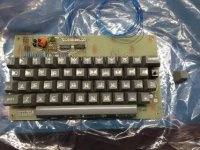I have three CT1024s presently and am debating selling one (the one without the keyboard). I snagged a power supply off ebay (the seller sent me what he thought was the original he'd had (he was the original owner), but it was for his old 6800 computer.. not the CT). My hesitation in selling it is that it, like the entirely hand built one I have here, is from the original owner. He even sent along his diagrams, original order sheets to SWTPC and there is some precious correspondence from them in there. I'm reluctant to let the latter stuff go, or separate them. The unit itself seems to be in working order (I've tested it off my original CT's PSU). Really I'd love to complete and build it.
That said, if we are headed into a world where keyboards are $500-5000, then it's likely never going to get done. I just can't in good conscience lay out that much money for something like that. The escalating costs of these things is kind of turning me against the hobby. I do however have some old keypunch keyboards I could conceivably convert, and as I've read it it's not unprecedented for a CT1024 owner to do that. So maybe that might be the route to go.

